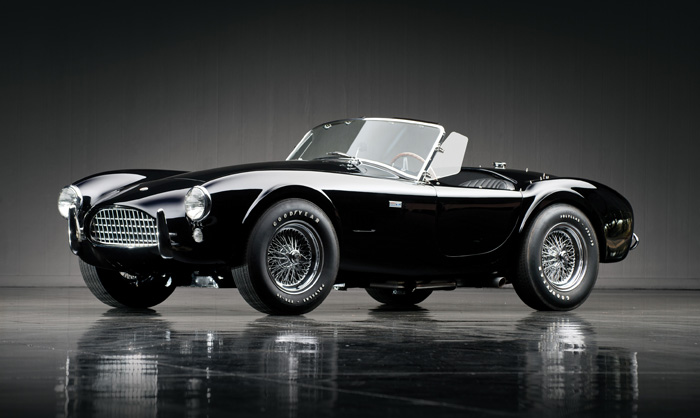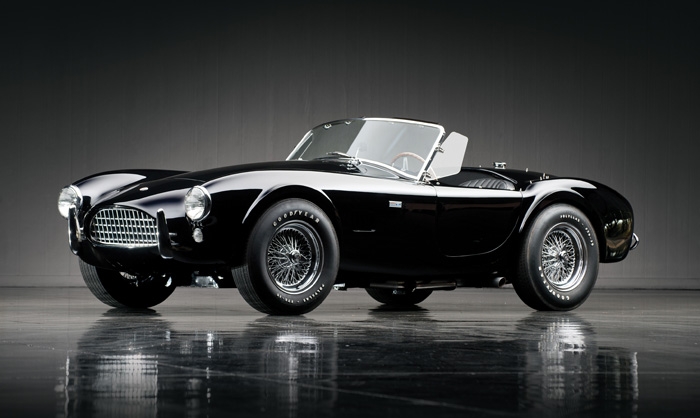
This car was originally billed to Shelby American on February 10, 1964, and it was shipped to Los Angeles aboard the SS Amsteldyk. It was later invoiced to Bill Doenges Ford of Tulsa, OK, on September 10, 1964, and it was originally painted bright blue with a red interior.
The first owner of 2332 was William Faulkner of Tulsa. Faulkner sold the car to Bob Crowder, who reportedly added the sidepipes and beefed up the 289 engine. Crowder sold the car in 1986, with 21,000 miles, to Jamey Mazzotta of Redding, CA, who later sold it to Andy Cohen of Beverly Hills. Cohen was the owner of Beverly Hills Motoring Accessories and featured the car in his 1991 parts catalog. The catalog noted that the car had a “375+ hp 289 motor, which has propelled this particular car to a 12-second-flat quarter-mile time!” The car subsequently passed to Jay Rawitzer of Danville, CA, who had the car through at least 2001. When the car was last advertised, it was noted that the car had 36,000 miles; the odometer now reads 36,798 miles.
Aside from the extensive history in the Registry, CSX2332 is accompanied by a small cache of important original paperwork, including the original Shelby American window sticker.
After acquiring the car, Davis commissioned a full restoration, which has made this example a standout among its peers.
SCM Analysis
Detailing
| Vehicle: | 1964 Shelby Cobra 289 |
| Years Produced: | 1963–65 |
| Number Produced: | 580 |
| Original List Price: | $5,995 |
| SCM Valuation: | $600,000–$1,000,000 |
| Tune Up Cost: | $250 |
| Distributor Caps: | $20 |
| Chassis Number Location: | Tag in engine compartment, hood latch, inside door |
| Engine Number Location: | Left side of engine |
| Club Info: | Shelby American Automobile Club (SAAC) |
| Website: | www.saac.com |
| Alternatives: | 1966 Shelby Cobra 427, 1929 Duesenberg Model J Tourer, 1971 Plymouth Hemi ’Cuda convertible |
| Investment Grade: | A |
This Cobra, Lot 112, sold for $1,001,000, including buyer’s premium, at RM Auction’s Don Davis sale on April 27, 2013.
The deafening racket you hear is not 1 million cicadas screeching love songs, it is the clatter of feverish keystrokes creating Internet posts about the most recent million-dollar 289 Cobra sale. This sale, combined with the other 289 Cobra RM hammered at this sale for $935k, and Gooding & Company’s $1.32m result for one in Scottsdale, have been the sales needed to alert the general public to what Cobra folks have known for quite some time: The Cobra market is on fire.
While most casual observers still think great 289 Cobras are $600k or less, anybody who has tried to buy one in the past 24 months knows that is no longer the case. Great cars, ones with all the right bits, squeaky-clean histories and coming from good homes, have been trading very close to that two-comma mark for a while.
The gold standard
Cobras have always been immune to many of the tried-and-true collector-car rules. As long as a Cobra had a decent history and was known to be the real car (i.e., not an “air car” or of otherwise sketchy origins) then things such as color changes, non-original engines, and modifications didn’t have much effect on value. Compared to the Corvette world, this is an odd phenomenon.
Logic tells us that any Cobra is so special that any non-original parts or go-fast mods didn’t change that fact that any Cobra was, well, a Cobra. They have always been highly collectible, blue-chip cars.
Chart their values over the past 50 years. It’s like watching the space shuttle blast off from Cape Canaveral on a plume of fire. To lose money on a Cobra used to be extremely hard to do. Pay too much? Time quickly fixed your sin. However, the higher prices became, the more people started to care. An incorrect block in a $50k Cobra is a non-issue, but in a million-dollar one? Big issue.
New money
And here’s where it gets really interesting: Today’s “new” Cobra buyers just know they want a Cobra. They don’t know the cars like the old-line Cobra diehards who can spot a correct screwdriver for the tool kit from 500 feet away. But the dyed-in-the-wool Cobra guys aren’t buying cars at today’s numbers. Heck, they already have their Cobras, and most have owned them for decades. The new buyers are clearly driving the new Cobra market, hustling to get in before prices potentially jump again.
This same thing has happened more than once in the past. One generation of owners bows out, another moves in, and the buyers fight with their wallets over any Cobra that hits the market, establishing new prices in the process.
There are always a lot more Cobra buyers than there are good cars. When I say “good” cars I mean extremely honest, well-known, well-sorted ones complete with things like those original screwdrivers.
The bad part for most buyers is that these kinds of Cobras don’t typically hit the open market. They don’t have to, as anybody who owns one simply has to tell a few friends it’s for sale and the car sells to another end user. And unless you really know these cars, a lesser Cobra can look exactly the same as a really good one to the untrained eye.
CSX2332
Where does our subject car, CSX2332, fit in?
I have not inspected the car in person since the Davis restoration, but I did review the photos in detail. I also inspected the car in person at the Mecum auction in 2010, where Mr. Davis bought the car for $550,000.
First, while the SAAC history is reasonably complete and shows no red flags, one has to remember that SAAC collects all this data through owners (think about that for a second) and a volunteer army that simply reports what they know about any particular car. And while this data is exceptionally valuable, it is not infallible or always complete.
So while 2332’s history reads very well and is straightforward in print, there is a little more to the story. When I inspected the car in 2010, I noted “exceptional original paperwork missing a car that matches.” I also found some areas of its aluminum skin and inner panels to be not typical of AC Cars’ work. Many important components were not original, including the drivetrain, from what I could see.
Further research revealed that 2332 did indeed run 12-second quarter-mile times — unfortunately, after its second owner had built it into a lightweight drag car. He sold off its original drivetrain, gauges, interior, and many other parts in the process.
In reviewing the photos from its post-Davis freshening, it was indeed exceptionally presented, but still certainly not correct. I’d personally rather see original and dull rather than fresh and shiny. Some items really jumped out, such as the front grille installed backwards, incorrect seats and gauges, the still-missing front bumper hoop, the incorrect wheels and late-1960s style Polyglas muscle-car tires. Many other details had Cobra guys pounding their keyboards.
A million-dollar experience
While this car wouldn’t make a purist’s list of the top 289 Cobras, I do hope it is well sorted mechanically and offers the new owner the famous Cobra ownership experience he or she is surely excited for. After all, that is not lessened with incorrect parts.
There is no denying 2332 is a stunning-looking 289 Cobra, and with some TLC many incorrect items could be fixed before its first SAAC outing. As for the price, while the best Cobras are indeed selling in this range (and higher, as the Gooding result shows), given the shiny-yet-not-correct restoration with 2332, I have to call this one very well sold, and I’m sure the old-line Cobra guys would agree.
However, it is proof of what most of us “insiders” have known for a while — million-dollar 289 Cobras are no longer a rarity.
(Introductory description courtesy of RM Auctions.)

Pingback: what did the tool kit shelby use in the cobra? · The Mytool